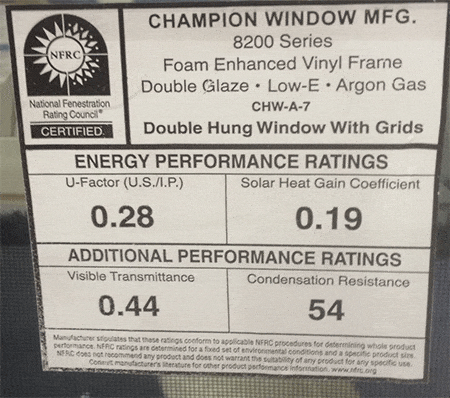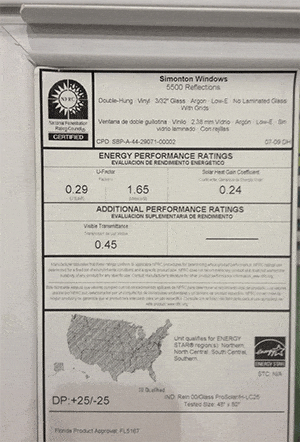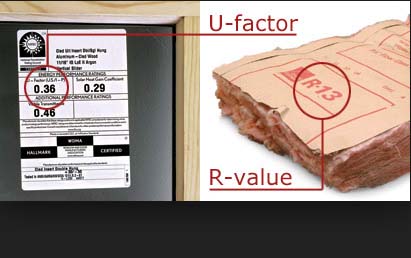As you’re shopping for new replacement windows you may have heard of NFRC ratings. It’s important to understand what these ratings are and what they mean about your new windows. First of all NFRC stands for the National Fenestration Rating Council. They’re based outside of Washington DC in Greenbelt Maryland. They are the national body that sets the standards for replacement window ratings.
Just about all new windows and doors offered today are NFRC rated as they need to be in order to qualify for the Energy Star program. The mice thing about NFRC ratings is that they are clear. Every new window will come with an NFRC sticker which clearly displays the ratings for that individual window or door. There is no room for salesperson trickery.

The NFRC stickers will look like the example above. As you can see they display the U-Factor and the Solar Heat Gain Coefficient (SHGC) on the top line and the Visible Transmittence (VT Rating) on the bottom left side. These are the ratings that MUST be on each window.
On the bottom line this window from Champion Windows also shows the Condensation Resistance which is optional. Some windows, like the Simonton window pictured below, will have a blank space in the lower right side. There is nothing wrong with this, but it does indicate that they don’t want to advertise their rating.

Why are NFRC ratings important?
These ratings are important because they are solid. They are not up for interpretation or subject to change at a moments notice.
We hear stories about salespeople with all sorts of bogus info. We see R-Values getting thrown around and hear about promises made to customers that are just plain impossible. The NFRC ratings provide a way to really evaluate what you’re actually getting to make sure it meets the promises you were made.
What should you do it the sticker does not match what you were told?
Whatever claims the company makes about the energy efficiency of their windows make sure to get them in writing. Let them know you’ll be checking it agains the NFRC stickers. If they match you’re doing great and if they don’t somebody has some explaining to do.
If you feel like you’re getting fishy numbers during the sales phase ask them for the real NFRC ratings. If the ratings you get don’t match what you were previously told then you know they were being tricky with you. If they were I would suggest you find another company. There are plenty of fish in the sea as they say.
Hopefully you caught these shenanigans during the sales process. If they’re not caught until the products are installed it will be harder to figure out a solution.
What if the windows do not come with NFRC stickers?
This probably means that the company removed them prior to installation which is a huge red flag. it may mean that they’re trying to hide something from you and there may be very little you can do about it at this point.
What’s the bottom line?
NFRC ratings are a great way to evaluate the differences between various window products. We see customers struggling with these evaluations all the time.
In fact, just today I got a call from one of our reps who was out meeting with a customer. The customer had asked our guy how thick the gap between the 2 panes of glass is. Before we go answering that question it’s important for us to identify what the customer is actually asking.
Does the customer care if there is 1/2″ or 3″ of space in there? Nope. What they want is an energy efficient window and some other company probably told them that you need to have this much space or that much space in order to be efficient. Of course the simple way to tell how efficient one window is compared to another is to look at the U-Factors on the NFRC sticker. If one is lower than it’s better and if it’s higher than it’s worse.
Does the space in-between the glass make any difference? Who cares. Either the ratings are better or they’re not better. The measurement of this dimension or that dimension don’t matter one bit. This is how NFRC ratings make window shopping easier.
Find more info on replacement window ratings here and you can find the most comprehensive and detailed replacement window reviews on the internet right here.
Have fun!
If you’re looking for a window company right now, the best advice we have is to check out our list of the best window companies all over the country. You can find it right here.







